“Welcome, dear friends, to ZAFS – the company that will take you on an adventure of a lifetime!” Alex, the team leader, introduced himself. The 11 of us were sitting around him on cane chairs placed on a green lawn in a quaint resort called the BruBru Lodge. A few hours ago, after landing at the Kilimanjaro International Airport in Tanzania, we drove into Moshi, a clean town with meandering roads lined with purple flower trees that were reminiscent of Japan’s cherry blossoms.
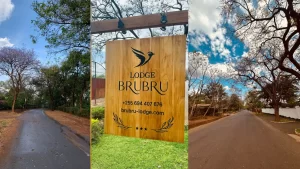
“It is not necessary that you reach the top,” Alex said, probably because of our varying shapes and sizes. “It’s more important that you enjoy the journey,” he continued. We were a mixed gang of people. There were two father-son duos: my dad (79 years) and me (43 years) and Ariz (48 years) and his son Zahan (15 years). We had two lawyer girls, Farnu and Hufriz (mid-forties) and one lawyer guy, Farhan (47 years). Sid (47 years) provided the spiritual balance we needed. Two pretty boys – Neville and Damin (early thirties) – helped bring the mean age down a little and enhanced its cosmetic appearance too, not taking anything away from the girls. Our leader from the Indian contingent was Jayesh (54 years) – a Maharashtrian always confused for being Gujarati, he’s said, who’s been atop more mountains than I can name. He is the founder of Odati Adventures, the adventure company that brought us to Kili.

The team of five guides checked all our climbing gear. “What is this?” John, another guide, asked me, pointing to my flimsy jacket. He was a Wesley Snipes doppelganger and had previously worked as a nightclub bouncer. “You will fly off at the summit in this!” he said in a deep African accent. What seemed inadequate was rented the next day for the week. That afternoon, we made our way for lunch to a charming open-air restaurant called the Jackfruit Café. However, as it was way past their closing time, all we got was jack. A thunderous downpour of unseasonal rain made us wonder if it would jeopardize our trail, as we were set to leave the next morning.

Day 1
It was the 28th of October. We were greeted by a team of 45 support staff, including guides, porters, toilet cleaners, waiters, and cooks – all holistically called ‘The Kili Warriors’. Their mission was to help us Kill the Kili: to conquer the mountain and summit the highest peak in Africa at 5,895 m (19,341 ft) above sea level. A traditional Masai robing ceremony marked the start of our journey, after which we were huddled into a bus that drove us 2 hours to the starting point of our trek via the Lemosho route, where we greeted a few giraffe enroute. “The average success rate of reaching the peak at Kili is about 60-80%,” Jayesh told us in the bus, “and choosing this route increases our chances, as it helps us acclimatise to the altitude better; the shorter route has a much higher failure rate,” he justified. In 2010, when Martina Navratilova attempted to climb the mountain, she had to make her way down at 4,500 m, as she developed a fluid build-up in her lungs. “Irrespective of one’s fitness, you can develop altitude sickness, and hence, acclimatization is key,” we were told.

After a quick lunch at the starting point, we made our way up from Lemosho Gate (2,100 m) to our first stop, the Big Tree Camp at 2,784 m. It was a gentle 6 km ascent that took around 4 hours, as we ambled through the canopy of the forest amidst gentle showers of rain. We were kept entertained by some Bollywood music that our African guide, Eric, played on his Bluetooth speaker and sang along to: “Har ghadi badal rahi hai roop zindagi, chhanv hai kabhi, kabhi hai dhoop zindagi…” The song was interestingly also indicative of the everchanging weather in the mountains, as the beaming sun suddenly made its presence felt, dappling through the leaves, as thick vines hung from towering trees. By the time we reached our campsite, our yellow igloo tents were set up for us betwixt awning tress from whose branches swung large, white-tailed colobus monkeys grabbing whatever food that was being prepared.

By evening, the temperatures began to dip into single digits. “This is the way to use the chemical toilet,” we were informed via a series of demonstrations. A clean toilet seat was covered by a tent over it and had a simple lever mechanism to make it work. In this freezing cold, the only thing missing was a seat warmer, which was automatically provided if you went immediately after someone else. I must confess that it required a few dumps for us to target our aim directly into the hole.

Before we tucked into a scrumptious meal of hot zucchini soup, corn salad, and chicken curry with vegetables, rice, and fruits, prepared by our famous mountain chef Zakaria, we were given the daily briefing for the next day. “You will wake up tomorrow morning around 6 AM shaaarp,” Alex informed us with a knife-edge emphasis on ‘sharp’. The ‘around’ that prefixed it made it hard not to smirk at the oxymoron. “Remember, the focus should be on the journey and not the destination,” he repeated, after a sleuth of instructions for the next day. We were off to bed by 9 PM.

Day 2
It is hard to sleep in the mountains. The sleeping bag keeps you warm but restricts your mobility. You keep tossing and turning, hoping you don’t need to pee and wondering when the sun will rise. We knew it did when Matata, one of our waiters, gave us a soothing, “Hello… good morning!” wakeup call at around 6 AM sharp. Hot, herbal Kilimanjaro tea was served in bed daily to warm our insides. There was going to be no bath for 8 days, just a sprinkle of warm water to brush. Once our morning ablutions were completed, we had breakfast, each day a varying combination of porridge, fruits, egg, pancakes, and dry fruits. Imagine carrying across this terrain over 20 trays of eggs without breaking even one! Today, we were going to saunter around 8 km over 7 hours from the Big Tree Camp to Shira 1 (3,499 m), and the landscape seemed like one from Jurassic Park, only without the dinosaurs. Our team set up high tea for us on a secluded plateau as we left behind the rain forest, filled with trees with lichen hanging off it called old man’s beard, to enter the moorland zone. As the trees fell away, tiny waist-high shrubs made their presence felt and we began to see the vastness that engulfed us.
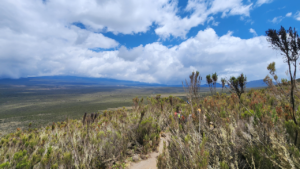
The Kili Warriors performed a song and dance routine for us after tea, where they introduced each of their 45 members amidst loud claps, cheers, salutations, and whistles. As temperatures dropped further that evening, we hoped to set up a small campfire to soak in the heat, but a few years ago, a large part of the mountain had burned down because of a wildfire, and building campfires was now prohibited. The only way to keep warm was to get into our tiny insulated tents with our ‘roomies’ and stay within touching distance of each other.
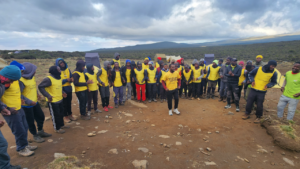
Day 3
Every day in the mountain feels like we are on a transcendental journey to answering a deep-seated call. For most people, it’s spiritual. For me, it’s more primordial: I can’t move unless my bowels do. The mountain language for wanting to use the toilet is decoded as sending a message. If you want to do su-su, you say you’re sending a short message. If you want to do potty, you’re sending a long message. Anything more accounts for writing an email. And, if you have diarrhoea like one of us did, you’re spamming with forwards.
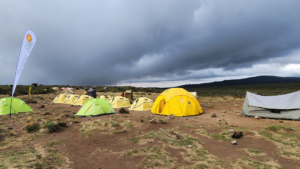
Today, we were going to walk 11 km from Shira Camp 1 to Moir Hut (4,160 m). We passed by a galactic stockpile of cairns, stones mounted atop each other by fellow trekkers to pray for their safe climb to the top, representing peace, calm, and being centred and grounded. Then, we navigated a few rocky faces to be immersed in every shade of brown – mahogany caves on the right, beige and copper ridges on our left, and a dusty almond track ahead of us – until we made it to camp, getting a good first glimpse of the majestic mountain. With every change in terrain, our guides reminded us to take our time, stay hydrated, and let our bodies adjust.
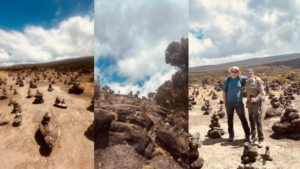
“What does Kilimanjaro mean?” I asked Alex as we approached camp. “The original name was Kili-ma-ki-yaro, given by the locals, but the Europeans called it Kilimanjaro to make it easy to pronounce, which some people say means ‘beautiful mountain,’” he explained, adding that there were many stories to its meaning. “Some initially called it the ‘unclimbable mountain’, but we now know that’s not true,” he laughed, having climbed it more than 200 times himself. “Hans Meyer was the first person to climb Mount Kilimanjaro in 1889,” Alex continued, “But I’m sure there must have been many locals before that,” he finished, lamenting on the lack of credit given to his people.
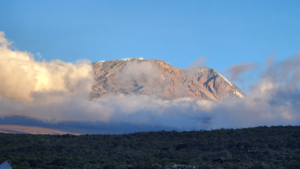
Day 4
The porters, guides, and chefs are like mountain goats: nimble-footed, swift, and untiring. Once we finish our breakfast and start walking for the day, they pack up our tents and all the other paraphernalia, overtake us, and set up another entire campsite complete with an elaborate lunch waiting for us before we arrive. And today, they did it twice, because we climbed up to the Larva Tower (4,600 m) where we had our lunch – vegetable stew, fried chicken, and sweetcorn salad with banana fritters for dessert – and then descended to the Barranco Camp (3,900 m) for dinner, where the locals provided a feast of Indian egg curry rice, dal, chapati, and chicken salad. The second highest mountain in Tanzania, Mount Meru, was seen peeking out amidst a candyfloss of white clouds. We reminisced about our friend with the same name who was supposed to have joined us on this trail but had fractured her leg a few months prior – although to mount Meru while her femur was healing might be unreasonable.
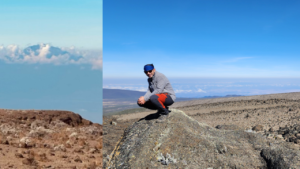
The sun was out all day and the only hydration that the parched tanned land got was from the droplets of mucus trickling down our noses in the cold. As the sun set through the clouds at Barranco, we could see the city lights glimmer in the distance below, as if reflecting a thousand stars of the clear sky above. It was customary for us to get our briefing each night before dinner. This was also when our oxygen saturation level and heart rate were checked, and we were asked if we had any of the characteristics of altitude sickness: headache, nausea, vomiting, or loss of appetite. “Pappa” (as the crew fondly called my dad) was not eating too well from Day 1. “You have to force yourself to eat,” John told him, cutting a special egg preparation they had made for him into small pieces to make it look more appetizing. Our support staff cared very diligently for each one of us. “Soup is not food, water and snacks is not food, coffee is not food. Only food is food!” John intoned in his deep staccato voice.

Day 5
At Barranco, the mountain’s imposing peak loomed ahead, both inspiring and intimidating. The Barranco wall is a sheer cliff rock face that looks daunting from a distance but is surprisingly easy to climb. Deep ridges in the mountain and well-positioned rocks required us only to put one foot ahead of the next and keep walking. “Pole, pole,” they kept egging us on. It was the mantra of the trek. Pronounced ‘po-lay’, it means, “Slowly, slowly,” in Swahili. Barranco also has the famous Kissing Rock, a giant boulder that requires you to hold it and brush your lips past it as you take a mid-air leap of faith across it.
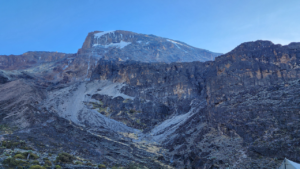
Our guides were so adept that they knew every single crevice in the mountain. “Alex, the next time, you must try this blindfolded!” I joked to spice up the trail a little. “Do you know that over the years, I have taken several blind people up the mountain?” he surprised me. “Not only blind, but also deaf and mute. Even amputees. Even people with cancer,” he gave me the lowdown. “Has anyone ever died?” I asked bluntly. Guides don’t like to talk about death. The mountain is their livelihood. They revere it. “Sometimes, things happen,” is the best I could get out of him as we reached a misty plateau where we broke for tea.
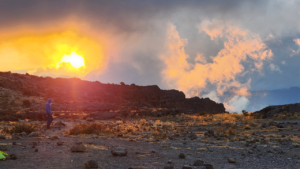
We headed to Karanga, our next campsite (4,000 m) after having walked 6-8 hours but having remained at the same altitude. Even though the mountain has so many ups and downs, it is the greatest leveller. Vegetation is sparse, limited to patches of tough grasses and the occasional resilient flower clinging to life. As we approached Karanga, heavy rain poured relentlessly from a cloudy sky, each drop crashing down like tiny hammers on the earth and filling the air with a steady, almost deafening roar. By the time we reached camp, the blazing sun was out again, ironing out our soaked woollens. Har ghadi badal rahi hai roop zindagi…
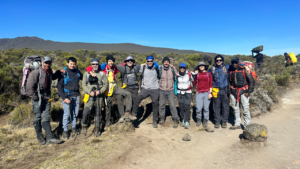
Day 6
The air was growing crisper with each passing morning and the temperatures dipped further. Even the toilet seat warmed by the previous person didn’t seem warm anymore. To add to it, while pooping, an alpine insect crawled over onto my groin. To be able to flick it off at minus temperatures without hurting the insect or the scrotum is a skill that can be mastered only in the mountains. At around 8 AM sharp, after breakfast, we took off for our final campsite, Kosovo (4,800 m). Dazzling views of the snow-capped mountain with its galactic glaciers were in touching distance as we encircled it. Mountain tops are like the girl you always wanted to date in high school: the closer you seem to get to the top, the further it goes away from you. We reached Kosovo after straining our backs trudging over the volcanic eruptions that had hardened a few thousand years ago. Our lunch was chicken curry rice, spaghetti, mixed veggies, and pineapple.
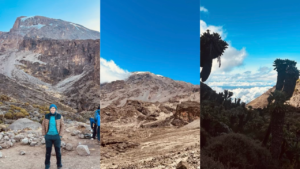
Tonight was going to be our summit night. We were scheduled to depart at 11 PM and climb 8 hours into the sunrise. This was the night all of us had been waiting for. The last leg of our 50 km climb. About 1,100 m to go. The past few days had seen us singing and dancing, cracking jokes, and pulling each other’s legs. Today was sombre, partly because the guides told “Pappa” that he shouldn’t risk the final push. He hadn’t been eating well and they were worried he didn’t have the nutrition needed to carry him through. It was not only 8 hours up, but another 8 hours down, as we had to descend twice the distance to the camp below. “But my heart is stronger than that of all the people in this group,” he insisted, as strong winds lashed upon our dining tent, threatening to uplift it. “The weather is worse than we expected it to be. You’ve come this far, which itself is more of an achievement than we could have imagined,” Alex and John told Pappa. “It’ll be our glory if we get you to the top,” they explained, “but not at any cost,” they reasoned. Pappa, usually quite strong-willed, realised that if something were to happen, it would mar the expedition, and conceded to their request to forgo the last lap. I could see his eyes well up. Letting go is often harder than holding on. Lessons we cannot learn at sea level are taught to us at high altitudes. “I’m happy to stay back with you,” I told him. “The summit means nothing to me. These are only labels. I’m just happy to be out in nature, and it’s been a great week so far,” I said. “No, you must go,” he insisted, “and I’ll see you when you’re down.” We bid a temporary goodbye.
The push to the summit
At around 11 PM sharp, we assembled in the dining tent for a final briefing. Each of us wore three layers of socks, four pants, and six layers on top: thermals, inners, top, a fleece jacket, down jacket, and windbreaker. The neck was buffed, the ears were muffed, and the head was chuffed. Headlights were put on, coffee was sipped, and bag packs were filled with 2 litres of hot water, which froze in no time. The wind was abnormally harsh that evening. We could hear it whistle through us in a shrill voice, like in horror movies before something bad is about to happen. We spoke in soft voices as if raising them would disturb the night. But there was no one else around. We did a team huddle and started our climb.
“Let’s all go up smiling and laughing,” I suggested. Everyone agreed. For the next couple of hours, we heard nothing but the sound of our own breathing. Each step was a slow, calculated effort as the thin air made every movement feel like a monumental task. We were ensconced in darkness. Only the lights on our head showed us the next step in front of us. “Why can’t we do this in the morning?” I asked. “If you get to see how daunting the mountain is, you’ll never be able to climb it,” John replied in darkness. “Also, the sun at the top is extremely harsh. It’ll exhaust you even further because it’s a straight steep climb up.” After what seemed like we had been bracing the harsh winds and freezing temperatures for a long while, someone asked for the time. “It’s 1:11 AM,” someone said looking at their watch. The angels were with us. We could leave our past behind and forge ahead. But even though the world had celebrated Diwali a day ago, the darkness that engulfed us seemed perennial. All we had to survive by was our own light, and all we hoped was that the battery wouldn’t knock off.
“Pole, pole,” they kept chanting and urging us to keep walking, taking breaks every hour to swallow some hot water. Every time we attempted to remove our gloves, haath mein aa gaye gole, gole. At around 4 AM, most of us started dozing off while walking. It is an unfathomable thought that at an altitude of 5,500 m, with winds blowing at 55 miles per hour in -15 degrees, a human could feel sleepy, but there it was. Oftentimes, our guides jerked us by the shoulder and shouted, “Don’t sleep, don’t sleep!” in a deep African baritone that still wakes me up in the middle of the night occasionally.
At 5:45 AM, in pitch darkness, we reached Stella Point (5,740 m). It is a so-called pseudo summit from which one starts walking along the edge of the crater of Mount Kilimanjaro to reach the ultimate peak – Uhuru – which, in Swahili, means ‘freedom’. The last one hour lay in front of us. The air was thin and frigid and the ground below solid rock. “What do people think of when they walk for hours in solitude?” I’ve always asked. Even though you’re surrounded by people, you are actually all alone. Some of us went through our lives, our families, our decisions, our choices, our regrets, our memories – all in slow motion; very different from having a near death experience, where your entire life flashes by you in a jiffy. Some replayed moments of the children in their lives, others of their parents. I thought of all the patients I had left behind, of all the challenging operations I’ve done, and wondered if I could have done them better. The patients I had lost and those who had survived despite me. The families I had consoled and those who had consoled me. All the while, we walked along the edge of the crater. A vast expanse of the deep hollow lay to the right and gorgeous icy glaciers on the left. The alpine desert had finally given way to the arctic zone.
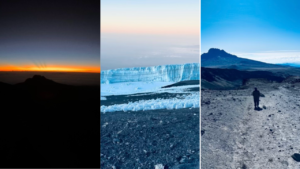
Then, cutting through the darkness, a sharp red circle emerged along the horizon as far as we could see. The circle grew thicker over the next few minutes and then began to change colour – scarlet… saffron… crimson… burgundy… amber – to suddenly being interspersed with perpendicular streaks of yellow colliding against the circle, splattering its crystals in all directions. The crescent of the rising sun galloped up behind the mountain into the sky, transforming into a giant ball of fire, throwing long shadows of us, making us appear bigger than we were. We had finally arrived at Uhuru – the highest point in Africa. This is what it meant to be free. Some of us had tears in our eyes, some felt a sense of relief, others a sense of wonder, and for most of us, it was a revelation, encapsulating the profound effect of reaching the peak after such a gruelling journey. I, instead, started vomiting. Freedom was not for me. I was attached. Attached to my people, my place, my purpose. I had to go down, realising that the hardest mountain to climb was the one within.
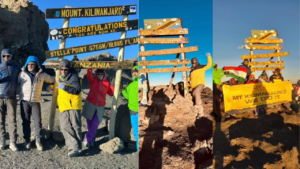
Taking some solace from the grace and warmth of the sun, we trotted 25 km over the next one and a half days, our toes jamming against our shoes as we descended and our knees reminding us of what it feels to be in your forties. The crew had arranged a closing ceremony with a grand lunch, where we were handed our certificates amidst song and dance, bells and whistles. We reached our hotel and showered for the first time in one week. Dirt and grime emitted out of body parts we didn’t expect. Hot water embraced sore thighs and achy feet. Chapped lips started to feel moist again.
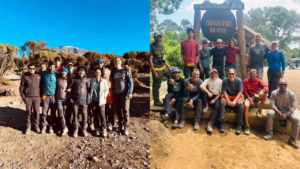
The only thing harder than climbing a mountain is explaining to someone why you did it. May be the freedom we all crave lies within. Like Sir Edmund Hilary said after scaling Mount Everest, “It is not the mountain we conquer, but ourselves.”

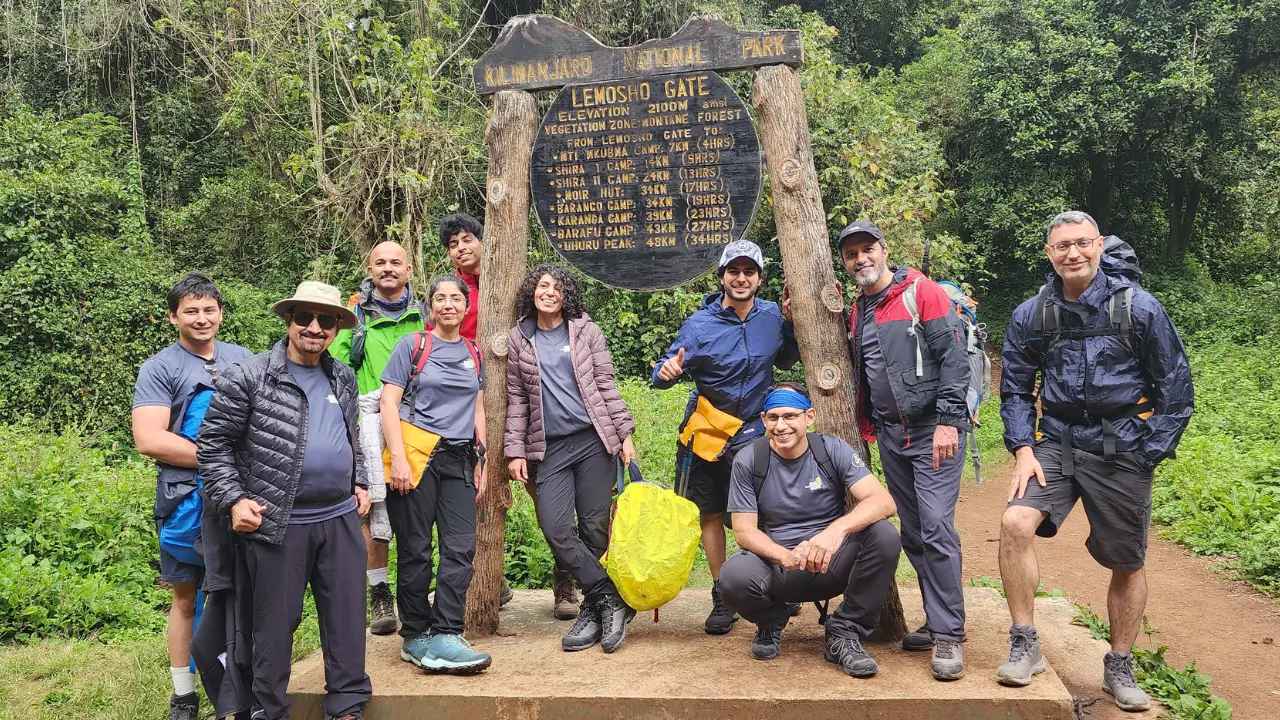



74 thoughts on “Mount Kilimanjaro: The Roof of Africa”
When the Bible states we are gods of the earth I felt this truth during my encounter with Lord Meduza the spell master. I’m Denzel Chau and I’m here to present the individual who transformed my life from poverty to becoming a multimillionaire Jackpot victor. I reached out to Lord Meduza for assistance with winning numbers and he successfully helped me after casting a lottery spell for me. I utilized the numbers to enter the Jackpot lottery and I was announced as the winner of $368,000,000. Acquiring the numbers from Lord Meduza took 72 hours and I want to express my gratitude publicly to him for his remarkable service to humanity and for deciding to assist me during my life’s lowest moment. Not everyone is meant to win the lottery, but with the assistance of Lord Meduza, you can achieve it. To reach him drop a message to his email: lordmeduzatemple@hotmail.com or Whats App +1 807 907 2687. To know more, visit: lordmeduzatemple.com and you’ll appreciate it later.
HOW I WON THE LOTTERY AND MY LIFE CHANGED: I’m a 26-year-old from Toronto and I just won $60 million in the lottery. Life was really hard before this and I was constantly struggling to pay my bills. While searching online for ways to turn things around, I came across stories of people saying that Lord Bubuza helped them win the lottery. I was curious and decided to give it a try. I reached out to him and he responded quickly. He told me what was needed to cast a lottery spell. After the spell was done, he gave me numbers to play. I used OLG’s Never Miss a Draw subscription and a few days later, I got a call saying I had won $60 million. I was completely shocked and overwhelmed with emotion. I never believed something like this could happen to me. I am truly grateful to Lord Bubuza for this incredible blessing. You can contact him via WhatsApp: +1 365 808 5313 or email: lordbubuzamiraclework@hotmail.com
HOW I WON THE LOTTERY AND MY LIFE CHANGED: I’m a 26-year-old from Toronto and I just won $60 million in the lottery. Life was really hard before this and I was constantly struggling to pay my bills. While searching online for ways to turn things around, I came across stories of people saying that Lord Bubuza helped them win the lottery. I was curious and decided to give it a try. I reached out to him and he responded quickly. He told me what was needed to cast a lottery spell. After the spell was done, he gave me numbers to play. I used OLG’s Never Miss a Draw subscription and a few days later, I got a call saying I had won $60 million. I was completely shocked and overwhelmed with emotion. I never believed something like this could happen to me. I am truly grateful to Lord Bubuza for this incredible blessing. You can contact him via WhatsApp: +1 365 808 5313 or email: lordbubuzamiraclework@hotmail.com ….!!!
For every ailment or disease, there exist natural herbs capable of providing complete recovery without any adverse effects. I have personally had numerous positive experiences with the herbal medicine I procured from Dr Aigbomian, which successfully eradicated my issue with the herpes virus. I am particularly impressed with the efficacy of these herbal products and would highly recommend them to anyone seeking a remedy for the herpes virus or other health conditions. here are his contact information, WhatsApp:+2349153323194
email: draigbomianherbalhome3@gmail.com
Unbelievable but true!
I’m Paul Corcoran, I still can’t believe how it happened, I actually won the $2,000,000 million dollars lottery after reaching out to Chief Ade, the man with the most powerful and genuine spell I’ve ever seen! I had lost all hope after years of trying my luck, but Chief Ade’s winning spell completely turned my life around. Within days everything changed, the numbers came through and my life has never been the same since. If you’ve been struggling or doubting, don’t wait too long Chief Ade is truly the real deal Email chiefadespellhome@gmail.com or WhatsApp +234 901 380 6328 THANK YOU
Unbelievable but true!
I’m Paul Corcoran, I still can’t believe how it happened, I actually won the $2,000,000 million dollars lottery after reaching out to Chief Ade, the man with the most powerful and genuine spell I’ve ever seen! I had lost all hope after years of trying my luck, but Chief Ade’s winning spell completely turned my life around. Within days everything changed, the numbers came through and my life has never been the same since. If you’ve been struggling or doubting, don’t wait too long Chief Ade is truly the real deal Email chiefadespellhome@gmail.com or WhatsApp +234 901 380 6328 THANK YOU
.
FOR CRYPTOCURRENCY RECOVERY, CONTACT TSUTOMU SHIMOMURA
This is the best crypto recovery company I’ve come across, and I’m here to tell you about it. TSUTOMU SHIMOMURA was able to 5:15 PM 30/12/2024 REGHWGHBHH recover my crypto cash from my crypto investment platform’s locked account. TSUTOMU SHIMOMURA just needed 24HRS to restore the $620,000 I had lost in cryptocurrencies. I sincerely appreciate their assistance and competent service. TSUTOMU SHIMOMURA may be relied on since they are dependable and trustworthy. you can also contact them Email address tsutomushimomurahacker@gmail.com, and I’m sure you will be happy you did.
HELLO EVERYONE.. FEW MUNINETS TO REDY THIS INFOR ON HERPES CURE 2018.. 2017 MY MOTHER WAS DIAGNOSED OF HERPES/ KNOWN AS GENITAL WARTS ,I SPENT A LOT OF MONEY ON HER MEDICATION TILL A POINT I EVEN LOST HOPE,BECAUSE MY MOTHER WAS GRADUALLY DYING AND LOST HER MEMORY TOO, I WAS SO DESPERATE TO GET MY MOTHER BACK TO NORMAL, ONE DAY MY UNCLE WHO LIVES IN LONDON UNITED KINGDOM TOLD ME ABOUT DR OSETALE ,WHO HELPED HIM GET RID OF HERPES /GENITAL WART WITH HERBAL MEDICINE AND HIS HERBAL SOAP ,I WAS SO SHOCKED WHEN HE TOLD ME ABOUT THIS ,ALTHOUGH I NEVER BELIEVE IN HERB BUT, I KEEP TO BELIEVE BECAUSE MY UNCLE CAN’T TELL ME LIES WHEN IT COMES TO HEALTH CONDITION I CONTACTED DR OSETALE VIA HIS EMAIL; OSETALEHEALER@GMAIL.COM , YOU CAN TALK TO HIM VIA CALL OR WHATSAPP MESSENGER ON +2349068271826 , HE REPLIED AND ASK ME TO SEND MY HOME ADDRESS AND MY MOTHER’S DETAIL AND THEN I PURCHASED THE HERBAL MEDICINE,SENT ME THE HERBAL MEDICINE THROUGH COURIER SERVICE, WHEN I RECEIVED THIS HERBAL MEDICINE USED IT FOR 2 WEEKS, AND 4 DAYS OF USAGE THE WARTS FELL OFF, MY MOTHER I NOW TOTALLY CURED AND MY MOTHER IS LIVING FREE AND HAPPY AGAIN. YOU CAN TALK TO DR VIA HIS MOBILE NUMBER OR WHATS APP HIM ON +2349068271826 ALL THANKS TO DOCTOR DR OSETALE HEALER
I was diagnosed with Parkinson’s disease four years ago. For over two years, I relied on Levodopa and several other medications, but unfortunately, the symptoms kept getting worse. The tremors became more noticeable, and my balance and mobility started to decline quickly. Last year, out of desperation and hope, I decided to try a herbal treatment program from NaturePath Herbal Clinic.
Honestly, I was skeptical at first, but within a few months of starting the treatment, I began to notice real changes. My movements became smoother, the tremors subsided, and I felt steadier on my feet. Incredibly, I also regained much of my energy and confidence. It’s been a life-changing experience I feel more like myself again, better than I’ve felt in years.If you or a loved one is struggling with Parkinson’s disease, I truly recommend looking into their natural approach. You can visit their website at http://www.naturepathherbalclinic.com.
I am Kemberly Dane from the USA . Herpes, a widespread viral infection, manifests as sores, often near the mouth or genitals. The herpes simplex virus (HSV) is the culprit, with two main types: HSV-1, linked to oral herpes (cold sores), and HSV-2, often associated with genital herpes. However, either type can affect either area. It’s important you reach out to Dr via WhatsApp +2347055029151 Email:- swordofspirit096@gmail.com for help to permanently get rid of it. He can also help you cast a love spell for someone or something you desire to have? Do you want wealth, or happiness, or a mate E.T.C. Lost lover specialist
1. We bring back lost lover
2. Do you want to win your loved one
3. We help single people to find partners
4. Do you want to be married?
5. Love attraction
6. Married problems & Divorce
8. Love potion
LORD BUBUZA LOTTERY SPELL MADE ME A WINNER: My name is Charles Coffey, I’m 81 years old, an Officer of the Order of Canada who has spent a lifetime standing for good causes. Yet today, I’m lost for words to thank Lord Bubuza the great lottery spell caster. I played Lotto Max for years but never won. My wife begged me to stop wasting money, and it broke my heart. One day, while searching online about life after retirement, I found people praising Lord Bubuza for helping them win the lottery. I decided to contact him through WhatsApp. He responded kindly and told me what was needed to cast a lottery spell. Just two hours after he completed the spell, Lord Bubuza sent me 7 numbers and a bonus number. I played them immediately and to my greatest surprise, I won $1,000,000. Lord Bubuza brought joy and hope back into my life when I needed it most. I will forever be grateful to him. Please join me in appreciating the great SPELL CASTER via email: Lordbubuzamiraclework@hotmail.com or WhatsApp: +1 (365) 808 5313
What’s up, just wanted to say, I loved this post.
It was practical. Keep on posting! https://Slotsgemcasinocanada.Wordpress.com/
My husband just woke up and decided our marriage was over. For a few months now, Mark and i have not been going well because he was having an affair with his assistant at work. I loved my husband so much and decided to stay and work on our marriage. In a short time, Mark stopped coming home and his close friend told me he has another apartment where he live with her. I was hurt and went on seeking for help because Mark was different from the man i married 10 years ago. Luckily, i found Dr OGBO who promised to return my husband back to me. He performed a reconciliation spell and he returned back and now we are both happy again with our boys. If you have issues like mine, send Dr OGBO Email psychicogboreading@gmail.com or contact him on Whatsapp +2349057657558
Unbelievable but true!
I’m Paul Corcoran, I still can’t believe how it happened, I actually won the $2,000,000 million dollars lottery after reaching out to Chief Ade, the man with the most powerful and genuine spell I’ve ever seen! I had lost all hope after years of trying my luck, but Chief Ade’s winning spell completely turned my life around. Within days everything changed, the numbers came through and my life has never been the same since. If you’ve been struggling or doubting, don’t wait too long Chief Ade is truly the real deal Email chiefadespellhome@gmail.com or WhatsApp +234 901 380 6328 THANK YOU
..
While searching on Google about getting an ex back, I literally discovered a great guide called Kwale Temple and I used his love binding spell to get over my divorce and win my wife back to my arms. Contact Kwale Temple today on kwaletemple@gmail.com . I urge you to check it out and you will get your ex back asap:
Unbelievable but true!I’m Paul Corcoran, I still can’t believe how it happened, I actually won the $2,000,000 million dollars lottery after reaching out to Chief Ade, the man with the most powerful and genuine spell I’ve ever seen! I had lost all hope after years of trying my luck, but Chief Ade’s winning spell completely turned my life around. Within days everything changed, the numbers came through and my life has never been the same since. If you’ve been struggling or doubting, don’t wait too long Chief Ade is truly the real deal Email chiefadespellhome@gmail.com or WhatsApp +234 901 380 6328 THANK YOU
What a wonderful world we are living in, I still doubt this spell caster how he did it!!! I am so happy to let the whole world know how this powerful spell caster saved my marriage.Everything was going down the drain as my husband could not stop cheating on me with other women. It became used to always heating on me. I tried to make him stop, but I couldn’t help the situation, the more I tried, the harder it became. At times we will fight and go apart for some months and we will come back again just because of our kids. One day a friend told me about this spell caster who helped her too, his name is Dr.oku, she said he uses white magic spells to solve spiritual problems. I decided to give it a try, I contacted him and he told me it will take just 2 to 3 days and I will see great changes in my husband. He actually cast a spell, believe me after 2 to 3 days of the spell, my husband was confessing different names of women he has slept with. He begged for forgiveness and never to try it again. From that day till now, my mind is at rest. My husband dislikes every other woman on earth except me. And am so happy to have him for myself alone.The spell caster’s contact is okutemple@gmail.com or whatapp +2347053113465
Unbelievable but true! I’m Paul Corcoran, I still can’t believe how it happened, I actually won the $2,000,000 million dollars lottery after reaching out to Chief Ade, the man with the most powerful and genuine spell I’ve ever seen! I had lost all hope after years of trying my luck, but Chief Ade’s winning spell completely turned my life around. Within days everything changed, the numbers came through and my life has never been the same since. If you’ve been struggling or doubting, don’t wait too long Chief Ade is truly the real deal Email chiefadespellhome@gmail.com or WhatsApp +234 901 380 6328 THANK YOU .
Powerful Herbal treatment is 100% guarantee for HSV cure, the reason why most people are finding it difficult to cure HSV 1 or 2 is because they believe on medical report, drugs and medical treatments which is not helpful to cure HSV and hasn’t proved any sign of helping. Natural roots/herbs are the best remedy which can easily eradicate herpes forever. I never believed it until I was helped and cured of my 16 months genital herpes with natural herbal medicines from Dr Sikies. Where other medical prescribed drugs and treatments failed, Dr Sikies natural herbs helped saved me from Genital herpes permanently and I’m so grateful for this. You can also get help from this great and powerful Herbalist Dr Sikies by reaching himon Email: drsikies@gmail.com / WhatsApp +2348163430143 website to make order now : https://drsikiesherbalcuremedicine.weebly.com/
It is a very hard situation when playing the lottery and never won, or keep winning low fund not up to 100 bucks, i have been a victim of such a tough life, the biggest fund i have ever won was 100 bucks, and i have been playing lottery for almost 11 years now, things suddenly change the moment i came across a secret online, a testimony of a spell caster called Dr.Isa who help people win in any type of lottery numbers, i was not easily convinced, but i decided to give a try, now i am a proud to be a lottery winner with the help of Dr.Isa spell, i won 2,000,000 Million dollars and i am making this known to everyone out there who have been trying all day to win the lottery, believe me this is the only way to win the lottery, this is the real secret we all have been searching for.
His WhatsApp: +2347046030096
Email: drisaspellcaster@gmail. com
I still can’t believe how my life has changed. I’m David Hatt from Kingston, Ontario. I went from struggling to keep up with bills to becoming one of the largest lottery winners the city has ever seen. meeting Chief Ade was a turning point in my life, and I know my journey will inspire a lot of people. Chief Ade’s guidance gave me hope when I needed it most, and that hope turned into the opportunity of a lifetime for me. I’m overwhelmed with gratitude, grateful for the blessing, grateful for the support, and grateful for making me believe it was possible ( Chief Ade ). Today I’m living a life I once only dreamed of, and I will never stops giving thanks to Chief Ade for making me one of the largest lotto max jackpot in Canadian history, I hope my story gives anyone who is trying to win the lottery faith that miracles really can happen with the help of Chief Ade Spell, Email: chiefadespellhome@gmail.com or WhatsApp +234 901 380 6328
I am Dr. Ayo Christopher, I am a Great traditional Herbal Medicine Doctor. I specialize in treating any kind of diseases and infections using natural Herbal Medicine. I have effective Herbal Cure for Herpes, scabiei mite, Diabetes, Virginal infection, Genital, Gonorrhea, warts virus infections, Leukemia, Lung Cancer, Menopause, Hepatitis A B C and HIV and other deadly infections. I have treated more than 20 patients that have Herpes (HSV 2) and all of them were cured. My herbal medicine is 100% safe, there are no side effects and You will start seeing clear results as early as 7 days.
If you have been taking conventional medicines for that Herpes infection and you are still having those re-occuring outbreaks, why don’t you try Herbal Medicines and see it get cured in weeks. For more information, send me an
Email: ridvid8@gmail.com
Telegram: @wafri01
website: //ridvid8.wixsite.com/dr-ayo-herbs-home/about-5
I still can’t believe how my life has changed. I’m David Hatt from Kingston, Ontario. I went from struggling to keep up with bills to becoming one of the largest lottery winners the city has ever seen. meeting Chief Ade was a turning point in my life, and I know my journey will inspire a lot of people. Chief Ade’s guidance gave me hope when I needed it most, and that hope turned into the opportunity of a lifetime for me. I’m overwhelmed with gratitude, grateful for the blessing, grateful for the support, and grateful for making me believe it was possible ( Chief Ade ). Today I’m living a life I once only dreamed of, and I will never stops giving thanks to Chief Ade for making me one of the largest lotto max jackpot in Canadian history, I hope my story gives anyone who is trying to win the lottery faith that miracles really can happen with the help of Chief Ade Spell, Email: chiefadespellhome@gmail.com or WhatsApp +234 901 380 6328
..
How I Healed from Herpes Simplex Virus with Holistic Herbal Remedies
The greatest joy in my life today is that I have been completely healed from Herpes, thanks to holistic herbal remedies.
In 2023, I was diagnosed with the Herpes Simplex Virus. I visited numerous hospitals seeking a cure, but nothing worked. I felt hopeless and frustrated, wondering if I would ever find a solution. Then, one day while browsing the internet, I came across a testimonial about how holistic herbal remedies had helped others heal from Herpes and various other diseases.
Intrigued, I reached out to the person who had shared their experience and contacted the herbalist via WhatsApp. He assured me that he could prepare a special herbal medicine for my condition. Two weeks later, after following his guidance and taking the herbal remedy, my Herpes symptoms had completely vanished.
Holistic herbal remedies are widely recognized for their effectiveness, and I want to share this hope with others. If you’re suffering from Herpes or any other similar health issue, know that there is a cure. The herbal medicine has no side effects, and there is no special diet required during treatment.
In addition to Herpes, the herbalist also helps cure a range of conditions, including ALS, cancer, HPV, diabetes, and more.
For more information, you can reach out via WhatsApp:
+44 7347 220754